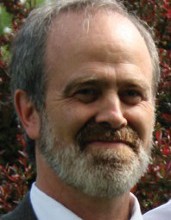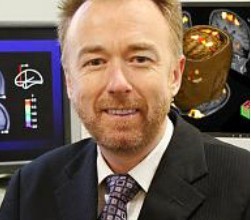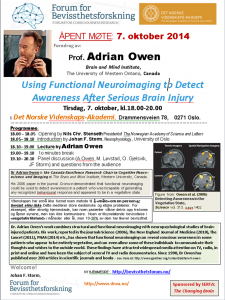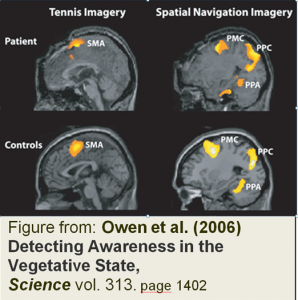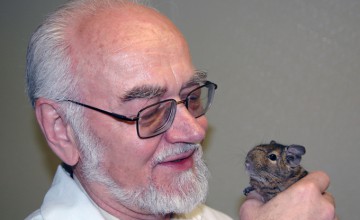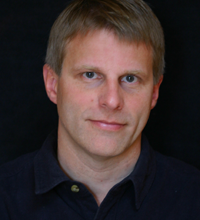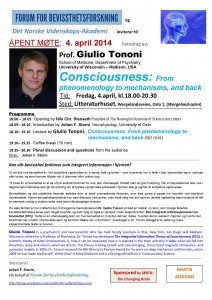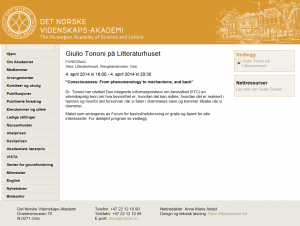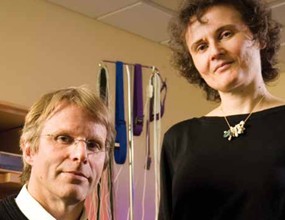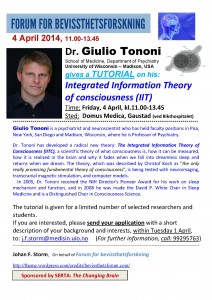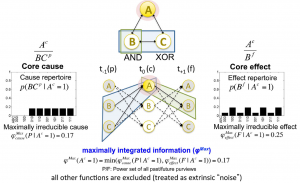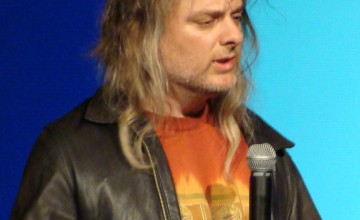| Event Start Date: 25. April 2025 | Event End Date: 25. April 2025 | Event Venue: |
Forum for bevissthetsforskning og Det Norske Videnskaps-Akademi
Forum for Consciousness Research and The Norwegian Academy of Science and Letters
invites you to an open meeting with a lecture by:
Professor Terrence W. Deacon
professor of Biological Anthropology and Linguistics at University of California-Berkeley.
“On consciousness –
Emergence of Life and Consciousness: How “self” can be physical and yet neither material nor energetic”
Time: Saturday 10 January, 2015: 14.00- 16.00,
Place: Litteraturhuset, Auditorium “Amalie Skram”*, Wergelandsveien 29, Oslo 1
Dr. Deacon is professor of Biological Anthropology and Linguistics at University of California-Berkeley.
Programme:
14.00 – 14.05 Opening by Professor Øivind Andersen, secretary general of The Norwegian Academy of Science and Letters
14.05– 14.10 Introduction by Johan F. Storm, Professor of Neurophysiology, University of Oslo
14.10– 15.10 Lecture by Terrence W. Deacon
15.10– 15.20 10 minutes break
15.20– 16.00 Panel discussion and questions from the audience
Bioschetch from http://anthropology.berkeley.edu/
Professor Deacon’s research has combined human evolutionary biology and neuroscience, with the aim of investigating the evolution of human cognition. His work extends from laboratory-based cellular-molecular neurobiology to the study of semiotic processes underlying animal and human communication, especially language. Many of these interests are explored in his 1997 book, The Symbolic Species: The Coevolution of Language and the Brain.
His neurobiological research is focused on determining the nature of the human divergence from typical primate brain anatomy, the cellular-molecular mechanisms producing this difference, and the correlations between these anatomical differences and special human cognitive abilities, particularly language. In pursuit of these questions he has used a variety of laboratory approaches including the tracing of axonal connections, quantitative analysis of regions of different species brains, and cross-species fetal neural transplantation. The goal is to identify elements of the developmental genetic mechanisms that distinguish human brains from other ape brains, to aid the study of the cognitive consequences of human brain evolution.
His theoretical interests include the study of evolution-like processes at many levels, including their role in embryonic development, neural signal processing, language change, and social processes, and how these different processes interact and depend on each other. Currently, his theoretical interests have focused on the problem of explaining emergent phenomena, such as characterize such apparently unprecedented transitions as the origin of life, the evolution of language, and the generation of conscious experience by brains. This is fueled by a career-long interest in the ideas of the late 19th-century American philosopher, Charles Sanders Peirce and his theory of semiosis. His new book, Incomplete Nature: How Mind Emerged from Matter, explores the relationship between thermodynamic, self-organizing, evolutionary and semiotic processes and provides a new technical conception of information that explains both its representational and normative Properties.
20150102_POSTER_DEACON-møte_FBF_10 jan_JFS13
Dr. Deacon is invited to Oslo by The Department of Social Anthropology, Faculty of Social Sciences, University of Oslo, to give a lecture on 7 January 2015:
Jan 7, 2015:
Instituttseminaret SAI (Sosialantropologisk insitutt, UiO): Terrence Tid og sted: Instituttseminaret SAI: Terrence Deacon foreleser 7. jan. 2015 14:15 – 16:00, Blindern, Eilert Sundts hus, rom 648 i 6. Etasje.
Tittel og abstract vil snart foreligge. Seminaret er åpent for alle, ingen påmelding påkrevet.
Jan 9, 2015:
Prof. Deacon will also lecture Jan 9, 2015 at Centre for Ecological and Evolutionary Synthesis, http://www.mn.uio.no/cees/english/ Friday seminar
In 2013, Deacon gave the lecture at the Bateson-symposium organised by SAI, UiO in 2013,: “Why systems thinking is not enough: From the origins of life to the current eco-crisis”. A video (app. 30 min) from this event is available on the internet through NRK.no (Kunnskapskanalen) http://tv.nrk.no/serie/kunnskapskanalen/MDFP15002114/01-11-2014#t=19s.
Bionote (from Wikipedia):
Prof. Deacon’s theoretical interests include the study of evolution-like processes at multiple levels, including their role in embryonic development, neural signal processing, language change, social processes, and focusing especially on how these different processes interact and depend on each other. He has long stated an interest in developing a scientific semiotics (particularly biosemiotics) that would contribute to both linguistic theory and cognitive neuroscience.
Deacon’s research combines human evolutionary biology and neuroscience, with the aim of investigating the evolution of human cognition. His work extends from laboratory-based cellular-molecular neurobiology to the study of semiotic processes underlying animal and human communication, especially language and language origins. His neurobiological research is focused on determining the nature of the human divergence from typical primate brain anatomy, the cellular-molecular mechanisms producing this difference, and the correlations between these anatomical differences and special human cognitive abilities, again, particularly language.[1]
Work
His 1997 book, The Symbolic Species: The Co-evolution of Language and the Brain is widely considered a seminal work in the subject of evolutionary cognition. His approach to semiotics, thoroughly described in the book, is fueled by a career-long interest in the ideas of the late 19th-century American philosopher, Charles Sanders Peirce. In it, he uses the metaphors of parasite and host to describe language and the brain, respectively, arguing that the structures of language have co-evolved to adapt to their brain hosts.
His 2011 book, Incomplete Nature: How Mind Emerged from Matter, explores the properties of life, the emergence of consciousness, and the relationship between evolutionary and semiotic processes. The book proposes a scientific theory of how properties such as information, value, purpose, meaning, and end-directed behavior emerged from physics and chemistry. Critics of the book argue that Deacon has drawn heavily from the works of Alicia Juarrero and Evan Thompson without providing full citations or references, but a UC Berkeley investigation exonerated Deacon.[2]
In contrast to the arguments presented by Juarrero in Dynamics of Action (1999, MIT Press) and by Thompson in Mind in Life (2007, Belknap Press and Harvard University Press), Deacon explicitly rejects claims that living or mental phenomena can be explained by dynamical systems approaches. Instead, Deacon argues that life- or mind-like properties only emerge from a higher-order reciprocal relationship between self-organizing processes.
http://en.wikipedia.org/wiki/Terrence_Deacon
Books
- The Symbolic Species: The Co-evolution of Language and the Brain. New York: W.W. Norton & Company. 1997. ISBN 978-0-393-31754-1
- Incomplete Nature: How Mind Emerged from Matter. New York: W.W. Norton & Company. 2011. ISBN 978-0-393-04991-6
Articles and essays
- Deacon, T.W. (1989). “Holism and associationism in neuropsychology: an anatomical synthesis.” in E. Perecman (Ed.), Integrating Theory and Practice in Clinical Neuropsychology. Erlbaum. Hilsdale, NJ. 1-47.
- Deacon, T.W. (1990). “Rethinking mammalian brain evolution.” Am Zool. 30:629–705.
- Deacon, T.W. (1997). “What makes the human brain different?” Annu. Rev. Anthropol. 26: 337-57.
- Deacon, T.W. (2001). “Heterochrony in brain evolution.” In Parker et al. (eds.), Biology, Brains, and Behavior. SAR Press, pp. 41–88.
- Deacon, T.W. (2006). “Emergence: The Hole at the Wheel’s Hub.” Chapter 5 in P. Clayton & P. Davies (Eds.), The Re-Emergence of Emergence: The Emergentist Hypothesis from Science to Religion. Oxford University Press, pp. 111–150.
- Deacon, T.W. (2006). “Reciprocal linkage between self-organizing processes is sufficient for self-reproduction and evolvability.” Biological Theory 1(2):136-149.
- Deacon, T.W. (2007). “Shannon-Boltzmann-Darwin: Redefining Information. Part 1.” Cognitive Semiotics 1:123-148.
- Deacon, T.W. (2008). “Shannon-Boltzmann-Darwin: Redefining Information. Part 2.” Cognitive Semiotics 2:167-194.
- Kull, Kalevi; Deacon, Terrence; Emmeche, Claus; Hoffmeyer, Jesper; Stjernfelt, Frederik. (2009). Theses on biosemiotics: Prolegomena to a theoretical biology. Biological Theory 4(2): 167–173.
- Deacon, T.W. (2010). “A role for relaxed selection in the evolution of the language capacity.” PNAS.107:9000-9006.
- Deacon, T.W. (2010). “On the Human: Rethinking the natural selection of human language” [1]
External links
- Terrence Deacon’s home page at the University of California, Berkeley – including online publications http://anthropology.berkeley.edu/users/terrence-w-deacon
- Interview with Terrence Deacon on the co-evolution of language and the brain
- Participants: Terrence W. Deacon, a biography in connection with his participation in “God, Matter, and Information: What is Ultimate?”, a 2006 symposium in Copenhagen.
- New York Review of Books review of Incomplete Nature http://emergence.org/McGinn.pdf
- http://www.nybooks.com/articles/archives/2012/oct/11/search-sentience/
